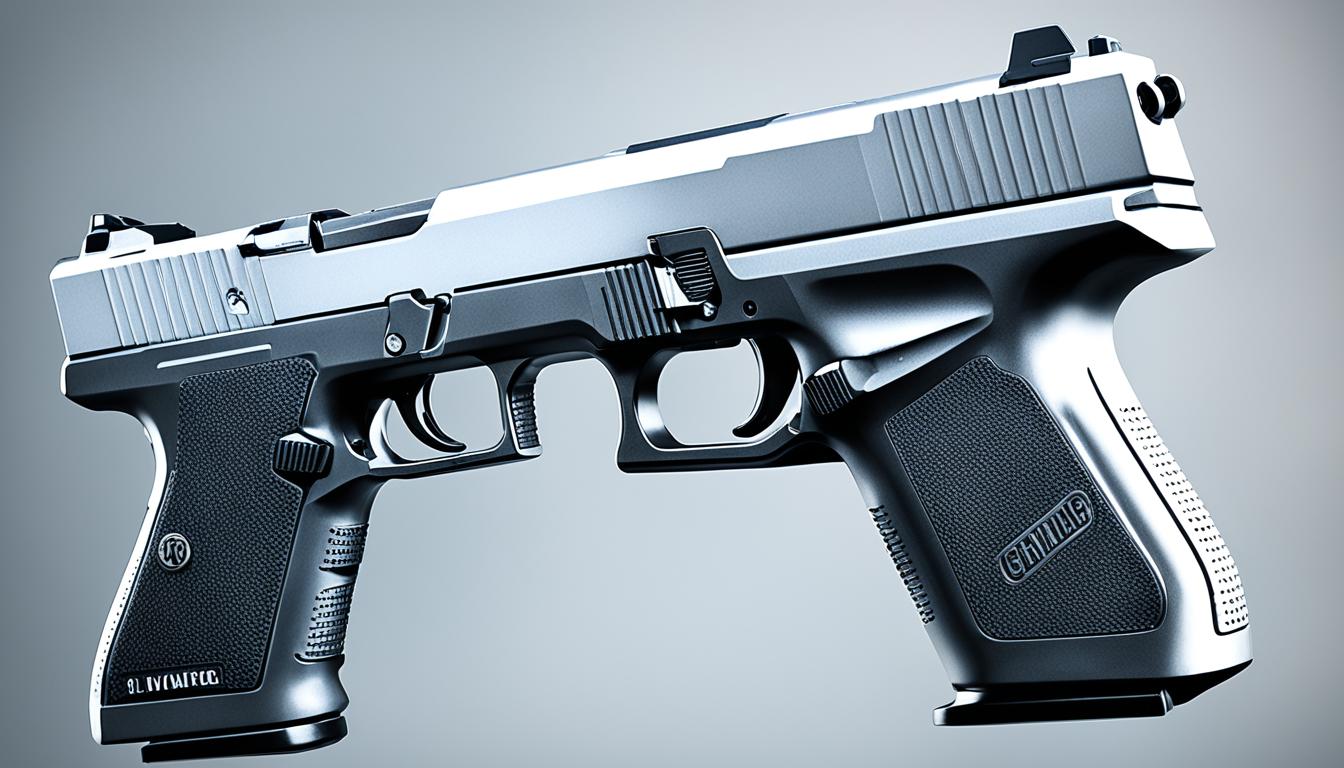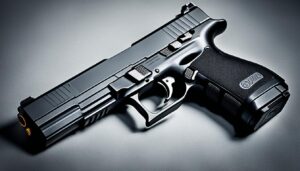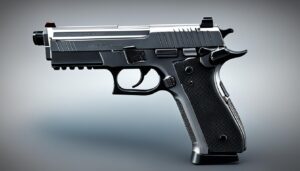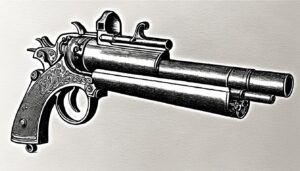When it comes to firearm safety and proficiency, selecting the right holster for your handgun is paramount. The crux of holster compatibility lies in understanding how handguns are classified by size, guiding us towards a secure and comfortable carry. Whether you’re a law enforcement officer, a shooting sports enthusiast, or a civilian carrying for self-defense, the compatibility between your firearm and its holster can greatly influence performance and convenience.
This introductory guide illuminates the essential criteria of firearm sizing and handgun dimensions, which are integral to ensuring your sidearm is snug, accessible, and unobtrusive. Grasping this foundation not only enhances carry comfort but also sharpens response times and supports the effective concealment of your defensive tool. Let’s delve into the nuances of handgun types and discover the holster fit guide that will revolutionize the way you equip yourself for daily readiness.
Understanding Handgun Size Categories
For gun enthusiasts and carriers of all levels, grasping the concept of handgun size categories is essential for making informed choices regarding concealed carry or open carry. Full-size pistols, compact handguns, sub-compact firearms, and the increasingly popular micro-compact pistols have distinct characteristics that cater to specific needs and preferences.
The Dimensions of Full-Size Handguns
Full-size pistols are often the go-to choice for duty carry by law enforcement and military personnel due to their substantial grip size, long sight radius, and higher magazine capacity. Typically, these sidearms feature a barrel length of around 4.5 to 5.5 inches and can accommodate magazine capacities of 15 rounds or more. Renowned for their precision, full-size models like the Glock 17 and the Beretta 92FS continue to set the standard for reliability in high-stress situations.
Compact Handgun Features
Compact handguns represent a balanced intersection between handling comfort and concealability, making them a preferred choice for concealed carry. Though they have shorter barrels and lower capacity magazines compared to their full-size counterparts, typically ranging from 3.5 to 4.5 inches in barrel length, they still provide an excellent grip. Notable examples include the Sig Sauer P320 Compact and the Smith & Wesson M&P9c, both of which boast a strong following among off-duty officers and civilian carriers alike.
Sub-Compact and Micro-Compact Handguns
Sub-compact firearms and micro-compact pistols are the quintessential partners for deep concealment and comfortable everyday carry. Despite their reduced dimensions and lighter frames, they don’t compromise on defensive capabilities. Sub-compacts often feature barrel lengths under 3.5 inches with magazine capacities that can still exceed 10 rounds. Turning to even smaller dimensions, the micro-compact market has burgeoned, highlighted by pistols like the Ruger LCP II and the Sig Sauer P365, which offer impressive magazine capacities for their minimal size.
| Category | Common Barrel Length | Typical Magazine Capacity | Popular Models |
|---|---|---|---|
| Full-Size | 4.5 to 5.5 inches | 15 rounds or more | Glock 17, Beretta 92FS |
| Compact | 3.5 to 4.5 inches | 12 to 15 rounds | Sig Sauer P320 Compact, Smith & Wesson M&P9c |
| Sub-Compact | Less than 3.5 inches | 6 to 10 rounds | Glock 26, Springfield Armory XD-S |
| Micro-Compact | Varies | 6 to 10 rounds | Ruger LCP II, Sig Sauer P365 |
Hand Guns Classified By Caliber and Barrel Length
When selecting the proper holster for a handgun, the caliber and barrel length are two critical factors that must be meticulously evaluated. These dimensions largely determine a firearm’s physical profile and, by extension, influence holster compatibility. Understanding the specifics can lead to a tailored fit within the holster, ensuring both security and accessibility for the user.
Impact of Caliber on Handgun Size and Holster Fit
The caliber of a handgun denotes the diameter of the firearm’s bore and, correspondingly, the size of the bullet it discharges. Various calibers necessitate holsters of different sizing, not only to accommodate the width of the gun but also to counterbalance the weight distribution of heavier or larger caliber firearms. Caliber-specific holsters are often designed to provide a snug fit and safeguard against unintentional movement or mishandling.
Barrel Length Considerations for Holster Selection
Barrel length is another important attribute in classifying handguns. It impacts both the overall length of the firearm and its balance. A correctly measured and matched barrel length to holster ensures that the firearm remains secure and easily accessible. When holster shopping, one should consult a holster fit guide to find specific product recommendations for various barrel lengths.
Here is an example of how caliber and barrel length affect the variety and type of holsters needed for different handguns:
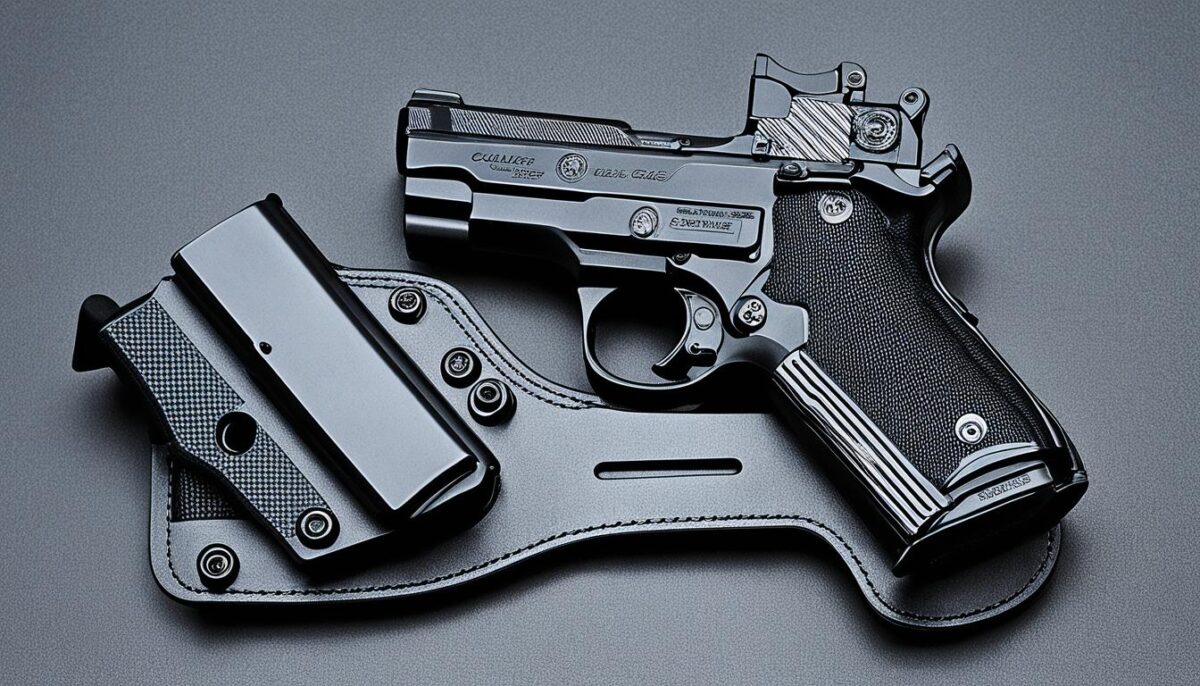
| Handgun Caliber | Typical Barrel Length | Recommended Holster Fit |
|---|---|---|
| .22 LR | 2-4 inches | Slim, compact holsters |
| 9mm | 3-5 inches | Standard concealed carry holsters |
| .45 ACP | 4-6 inches | Duty or custom holsters |
| .357 Magnum | 2-6 inches | Heavy-duty or reinforced holsters |
For enthusiasts and professionals alike, it’s prudent to have a bespoke holster created when the firearm deviates from standard sizing. Custom holsters can be an ideal solution to address unique handgun dimensions and the owner’s specific carry needs.
Choosing the correct holster requires consideration of both handgun caliber and barrel length to ensure a proper fit. Armed with this knowledge, carriers can have confidence that their firearm will be secure, accessible, and ready for any situation. Always remember, whether you opt for caliber-specific holsters or a personalized custom holster, the perfect fit is paramount for both efficiency and safety.
Choosing the Right Holster for Your Handgun
Finding a perfect mate for your firearm in the vast sea of holsters can be daunting. Yet, the right choice is imperative for ensuring safe carry, quick access, and overall comfort. This essential holster selection guide will aid you in securing handgun-holster compatibility. Whether you’re a law enforcement officer or a civilian carrying for self-defense, the attention to detail in matching your handgun to an ideal holster cannot be overstated.
Factors to Consider When Matching Holsters to Handgun Size
When deliberating over holster options, key factors come into play. The handgun model is primary: a full-size service pistol requires a differently contoured carriage compared to a compact sidearm. The intended use — be it concealed carry, range practice or duty wear — influences design choice profoundly, impacting the holster’s profile and retention features. Carry position, whether IWB (Inside the Waistband), OWB (Outside the Waistband), ankle, or shoulder, sets the stage for how the holster will sit against the body. Lastly, personal comfort is a quintessential aspect: an uneasy holster can alter your movement and draw, proving detrimental in critical moments.
The Role of Holster Material in Compatibility
Materials like leather, Kydex, and nylon aren’t just about aesthetics; they define the functionality and durability of your holster. Leather holsters, aged and tested through time, mold to the firearm and wearer, promising a tailored fit that improves with use. Kydex holsters, on the other hand, are synonymous with ruggedness and a consistent draw, thanks to their firm structure. Nylon offers a lightweight yet versatile option with adjustable features, catering to a wide range of firearms. Each material lends itself to varying degrees of concealability, security, and longevity — attributes that must align with your specific needs.
Custom vs. Universal Holsters for Different Gun Sizes
In the realm of custom versus universal holsters, the debate is tailored precision against adaptable fit. Custom holisters are crafted to hug every curve of your specific handgun model, reducing wiggle room and enhancing retention. Universal holsters, conversely, offer a broader spectrum of fit, potentially accommodating multiple handguns within a size range. While they are generally more economical and readily available, they may not provide the snug fit of a custom counterpart. The choice hinges on your priority: the absolute certainty of a bespoke creation or the flexible accommodation of a semi-universal design.

